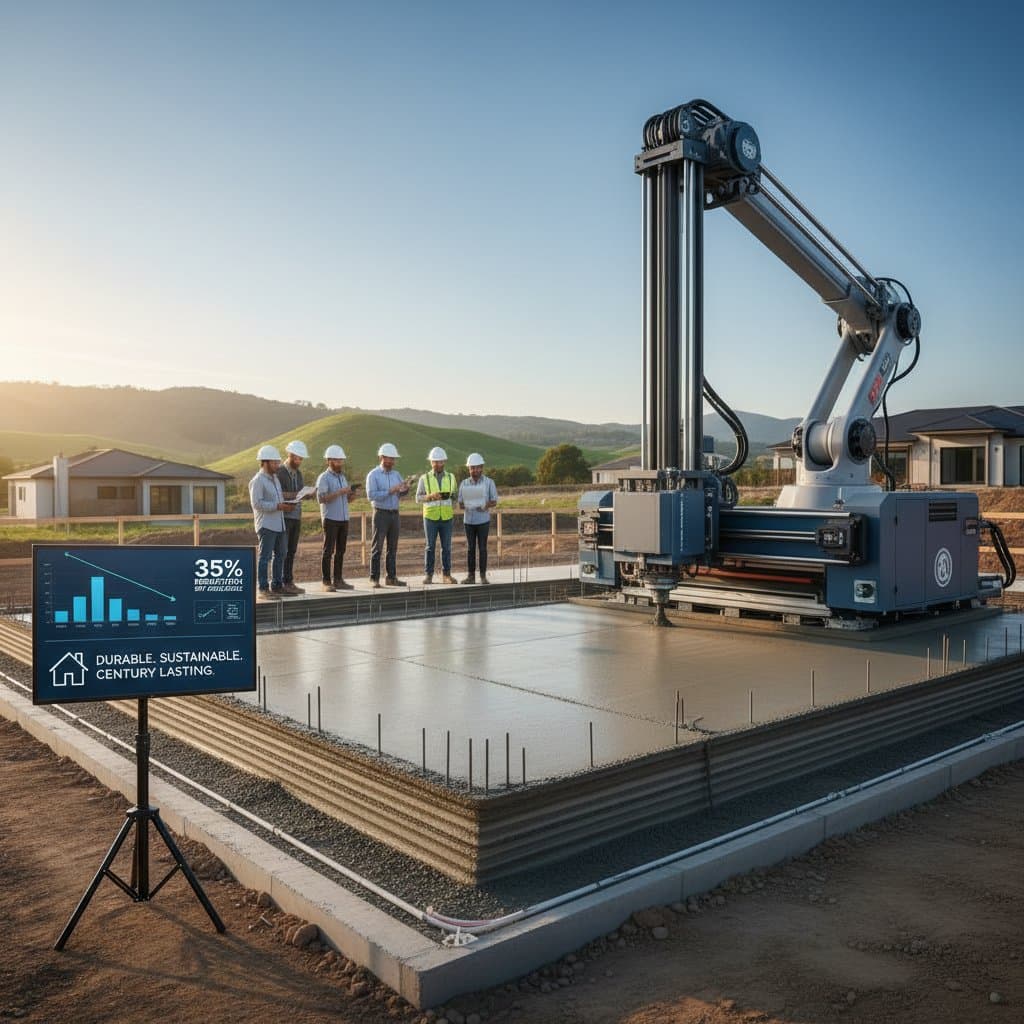3D Printing Revolutionizes Foundation Construction with 35% Cost Savings by 2025
Advancements in concrete technology make building foundations smarter, faster, and more affordable. 3D printed concrete foundations reduce costs by approximately one-third relative to conventional approaches. Traditional processes that demand weeks for forming, pouring, and curing now yield to printing completed in days through automated accuracy. Homeowners and builders benefit from enhanced structural integrity, decreased labor expenses, and reduced on-site waste.
This article examines 3D printed foundations, their operational principles, and projections for costs, installation, and durability. It covers ideal scenarios for adoption, essential pre-project verifications, and integration into broader residential building practices.
Advantages and Disadvantages
Advantages
- Cost efficiency. Labor and material waste diminish, lowering overall foundation expenses by 30 to 40 percent.
- Rapid execution. A typical residential foundation prints in days rather than weeks.
- Exactitude. Digital blueprints prevent alignment mistakes and guarantee even surfaces.
- Environmental benefits. Concrete usage decreases, and formwork waste approaches zero.
- Customization potential. Complex curves, bespoke forms, and embedded elements such as conduits or insulation pathways become feasible.
Disadvantages
- Equipment requirements. Substantial printers demand ample space and firm terrain.
- Expertise scarcity. Trained contractors remain limited in number.
- Material consistency. Reliable supply and temperature regulation prove essential.
- Regulatory challenges. Certain building authorities continue to adapt evaluation protocols for printed elements.
- Post-installation adjustments. Repairs or alterations necessitate specialized equipment.
Durability and Upkeep
A well-executed 3D printed concrete foundation endures 80 to 100 years with routine care, comparable to poured concrete counterparts. Success hinges on thorough curing and effective moisture management at the outset.
Routine maintenance includes:
- Annual examinations for fissures or subsidence.
- Diversion of surface runoff from wall bases.
- Application of permeable sealants to exposed areas every 10 to 15 years.
- Vigilance against footing erosion in humid environments.
Layer fusion during printing minimizes cold joints, thereby lowering susceptibility to future fractures. Appropriate reinforcement safeguards against ground movement or freeze-thaw cycles.
Preparation and Site Readiness
3D printing requires a stable, graded, and drained location. Prior to printer deployment:
- Site survey and marking. Confirm boundaries, heights, and offsets.
- Excavation work. Eliminate organic materials and unstable backfill.
- Foundation bed. Compact gravel or crushed stone to 6 to 12 inches depth as specified.
- Utility safeguards. Locate and shield electrical, plumbing, and gas conduits.
- Access facilitation. Clear pathways for printer mobilization to the site.
- Environmental mitigation. Schedule shading or protective enclosures for extreme heat or precipitation.
Foundations often incorporate built-in channels or anchors for subsequent framing, demanding close collaboration with wall assembly teams.
Design Variations and Selections
Customization options abound for 3D printed foundations:
- Monolithic walls. Continuous printing suits standard dwellings.
- Honeycomb structures. Material efficiency increases while strength persists.
- Cavity insulation designs. Provisions for foam integration enhance heat retention.
- Combined footing and wall prints. Single-pass construction for footings and stems.
Selections align with geotechnical factors, efficiency targets, and load-bearing needs. Insulated cavities suit frigid locales, whereas integrated trenches accelerate progress on level terrain.
Potential Issues and Resolutions
Durability defines printed foundations, yet oversights invite complications.
Frequent challenges:
- Delamination of layers. Arises from variable mixtures or pauses in printing.
Resolution: Re-print segments or bond with grout prior to hardening. - Fractures. Stem from differential drying or foundational settling.
Resolution: Employ epoxy fillers or elastic repairs. - Inadequate curing. Yields brittle exteriors.
Resolution: Maintain moisture in initial phases and stabilize temperatures. - Ineffective drainage. Promotes base accumulation of water.
Resolution: Adjust grading or install peripheral drainage systems.
Prompt identification via inspections and acoustic testing averts escalation to major concerns.
Considerations for Regions and Weather
Printed concrete adapts to diverse environments, though adaptations address specific risks.
- Cold climates with freeze-thaw. Incorporate air-entraining agents and drainage to avert spalling.
- Arid hot zones. Regulate mixture temperatures and provide print-site shading against early solidification.
- Seaside locations. Integrate rust preventatives or fiber reinforcements against salinity.
- Swelling clay areas. Pair with extended pilings or piers for firmness.
- Precipitous regions. Apply impermeable barriers and boundary drains.
Regional specialists customize formulations; request localized performance documentation.
Comparable Foundation Methods
Where 3D printing availability lags, viable alternatives persist.
- Insulated concrete forms. Polystyrene blocks enclose poured concrete for robust, insulated barriers.
- Prefabricated segments. Off-site molded units assemble swiftly with uniform quality.
- Tensioned slab systems. Cable reinforcements stabilize over expansive ground.
- Shallow insulated bases. Insulation permits reduced digging in frosty areas.
Implementing 3D Printed Foundations
Prospective builders find 3D printed foundations ideal for expense reduction and accuracy enhancement. Verify contractor credentials for load-bearing applications.
Request:
- Prototype demonstrations or trial builds.
- Engineering validation reports.
- Assurance of regulatory adherence.
- Comprehensive pricing, encompassing embeds and post-print processes.
Anticipate utility placements and framing compatibilities. Align designs so wall attachments match printed features.
This evolution transcends experimentation; it redefines workflows, financial planning, and construction velocity. Homeowners gain dependable economies as automation fortifies the groundwork of new residences.
